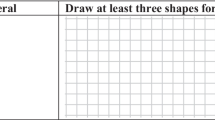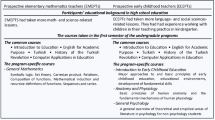Abstract
We discuss a teaching experiment that explored two pre-service secondary teachers’ meanings for the unit circle. Our analyses suggest that the participants’ initial unit circle meanings predominantly consisted of calculational strategies for relating a given circle to what they called “the unit circle.” These strategies did not entail conceiving a circle’s radius as a unit of measure. In response, we implemented tasks designed to focus the participants’ attention on various measurement ideas including conceiving a circle’s radius as a unit magnitude. Against the backdrop of the participants’ actions on these tasks, we characterize shifts in the participants’ unit circle meanings and we briefly describe how these shifts influenced their ability to use the unit circle in trigonometric situations.













Similar content being viewed by others
Notes
This presents one of the difficulties in the teaching and learning of the unit circle. As soon as a circle is put on paper, a circle with a particular radius length has, in a way, been specified.
We produced the original diagram with given measures.
We produced the original diagram with given measures.
This assumes that the quantity’s magnitude is not varying. In the case that the quantity’s magnitude is varying, an invariant relationship exists between the unit-measure pairs for any instantiation of the quantity’s magnitude.
The radius is often defined as a distance, and thus the phrase a radius of one radius length might seem redundant. We point out that the one in the phrase a radius of one, to students, does not necessarily entail thinking about the radius as a unit magnitude.
References
Akkoc, H. (2008). Pre-service mathematics teachers’ concept images of radian. International Journal of Mathematical Education in Science and Technology, 39(7), 857–878.
Breidenbach, D., Dubinsky, E., Hawks, J., & Nichols, D. (1992). Development of the process conception of function. Educational Studies in Mathematics, 23(3), 247–285.
Bressoud, D. M. (2010). Historical reflections on teaching trigonometry. Mathematics Teacher, 104(2), 106–112.
Brown, S. A. (2005). The trigonometric connection: Students’ understanding of sine and cosine. Ph.D. Dissertation. Illinois State University: USA.
Harel, G., & Sowder, L. (2005). Advanced mathematical-thinking at any age: Its nature and its development. Mathematical Thinking and Learning, 7(1), 27–50.
Hertel, J., & Cullen, C. (2011). Teaching trigonometry: A directed length approach. In L. R. Wiest, T. Lamberg (Eds.), Proceedings of the 33rd Annual Meeting of the North American Chapter of the International Group for the Psychology of Mathematics Education (pp. 1400–1407). Reno, NV: University of Nevada, Reno.
Kendal, M., & Stacey, K. (1997). Teaching trigonometry. Vinculum, 34(1), 4–8.
Moore, K. C. (2013). Making sense by measuring arcs: A teaching experiment in angle measure. Educational Studies in Mathematics, 83(2), 225–245.
Moore, K. C. (2014). Quantitative reasoning and the sine function: The case of Zac. Journal for Research in Mathematics Education, 45(1), 102–138.
Piaget, J. (2001). Studies in reflecting abstraction. Hove: Psychology Press Ltd.
Reed, S. K. (2006). Does unit analysis help students construct equations? Cognition and Instruction, 24(3), 341–366.
Sierpinska, A. (2003). Visualization is in the mind of the beholder. New Zealand Journal of Mathematics, 32, 173–194.
Steffe, L. P., & Olive, J. (2010). Children’s fractional knowledge. New York: Springer.
Steffe, L. P., & Thompson, P. W. (2000). Teaching experiment methodology: Underlying principles and essential elements. In R. Lesh & A. E. Kelly (Eds.), Research design in mathematics and science education (pp. 267–307). Hillside: Erlbaum.
Strauss, A. L., & Corbin, J. M. (1998). Basics of qualitative research: Techniques and procedures for developing grounded theory (2nd ed.). Thousand Oaks: Sage Publications.
Tall, D. (Ed.). (1991). Advanced mathematical thinking. Dordrecht: Kluwer.
Thompson, P. W. (1979). The constructivist teaching experiment in mathematics education research. Paper presented at the Annual Meeting of the National Council of Teachers of Mathematics, Boston, MA.
Thompson, P. W. (1990). A theoretical model of quantity-based reasoning in arithmetic and algebra. San Diego: Center for Research in Mathematics & Science Education, San Diego State University.
Thompson, P. W. (1994). Images of rate and operational understanding of the fundamental theorem of calculus. Educational Studies in Mathematics, 26(2–3), 229–274.
Thompson, P. W. (2008). Conceptual analysis of mathematical ideas: Some spadework at the foundations of mathematics education. In O. Figueras, J.L. Cortina, S. Alatorre, T. Rojano, & A. Sépulveda (Eds.), Proceedings of the Annual Meeting of the International Group for the Psychology of Mathematics Education (Vol. 1, pp. 45–64). Morélia, Mexico: PME.
Thompson, P. W. (2011). Quantitative reasoning and mathematical modeling. In S. Chamberlin, L. L. Hatfield, & S. Belbase (Eds.), New perspectives and directions for collaborative research in mathematics education: Papers from a planning conference for WISDOM^e (pp. 33–57). Laramie: University of Wyoming.
Thompson, P. W. (2013). In the absence of meaning. In K. Leatham (Ed.), Vital directions for research in mathematics education (pp. 57–93). New York: Springer.
Thompson, P. W., Carlson, M. P., Byerley, C., & Hatfield, N. (2014). Schemes for thinking with magnitudes: A hypothesis about foundational reasoning abilities in algebra. In L. P. Steffe, K. C. Moore, L. L. Hatfield, & S. Belbase (Eds.), Epistemic algebraic students: Emerging models of students’ algebraic knowing (pp. 1–24). Laramie: University of Wyoming.
Thompson, P. W., Carlson, M. P., & Silverman, J. (2007). The design of tasks in support of teachers’ development of coherent mathematical meanings. Journal of Mathematics Teacher Education, 10, 415–432.
Thompson, P. W., & Harel, G. (in preparation). Standards of understanding.
Thompson, P. W., Harel, G., & Thomas, M. O. J. (2015). Teaching and learning calculus from middle grades through college. London: Routledge (in press)
Topçu, T., Kertil, M., Akkoç, H., Yilmaz, K., & Önder, O. (2006). Pre-service and in-service mathematics teachers’ concept images of radian. In J. Novotná, H. Moraová, M. Krátká & N. Stehlíková (Eds.), Proceedings of the 30th Conference of the International Group for the Psychology of Mathematics Education (Vol. 5, pp. 281–288). Prague: PME.
von Glasersfeld, E. (1995). Radical constructivism: A way of knowing and learning. Washington: Falmer Press.
Weber, K. (2005). Students’ understanding of trigonometric functions. Mathematics Education Research Journal, 17(3), 91–112.
Wildi, T. (1991). Units and conversion charts: The metrification handbook for engineers and scientists. New York: IEEE Press.
Acknowledgments
This material is based upon work supported by the National Science Foundation under Grants No. DRL-1350342 and EHR-0412537. All opinions expressed are solely those of the authors and do not necessarily reflect the views of the National Science Foundation. Thank you to SIGMAA on RUME for the opportunity to present a previous version of this manuscript. Thank you to Patrick Thompson for his feedback on previous versions of the manuscript and his suggestions for important clarifications.
Author information
Authors and Affiliations
Corresponding author
Rights and permissions
About this article
Cite this article
Moore, K.C., LaForest, K.R. & Kim, H.J. Putting the unit in pre-service secondary teachers’ unit circle. Educ Stud Math 92, 221–241 (2016). https://doi.org/10.1007/s10649-015-9671-6
Published:
Issue Date:
DOI: https://doi.org/10.1007/s10649-015-9671-6




